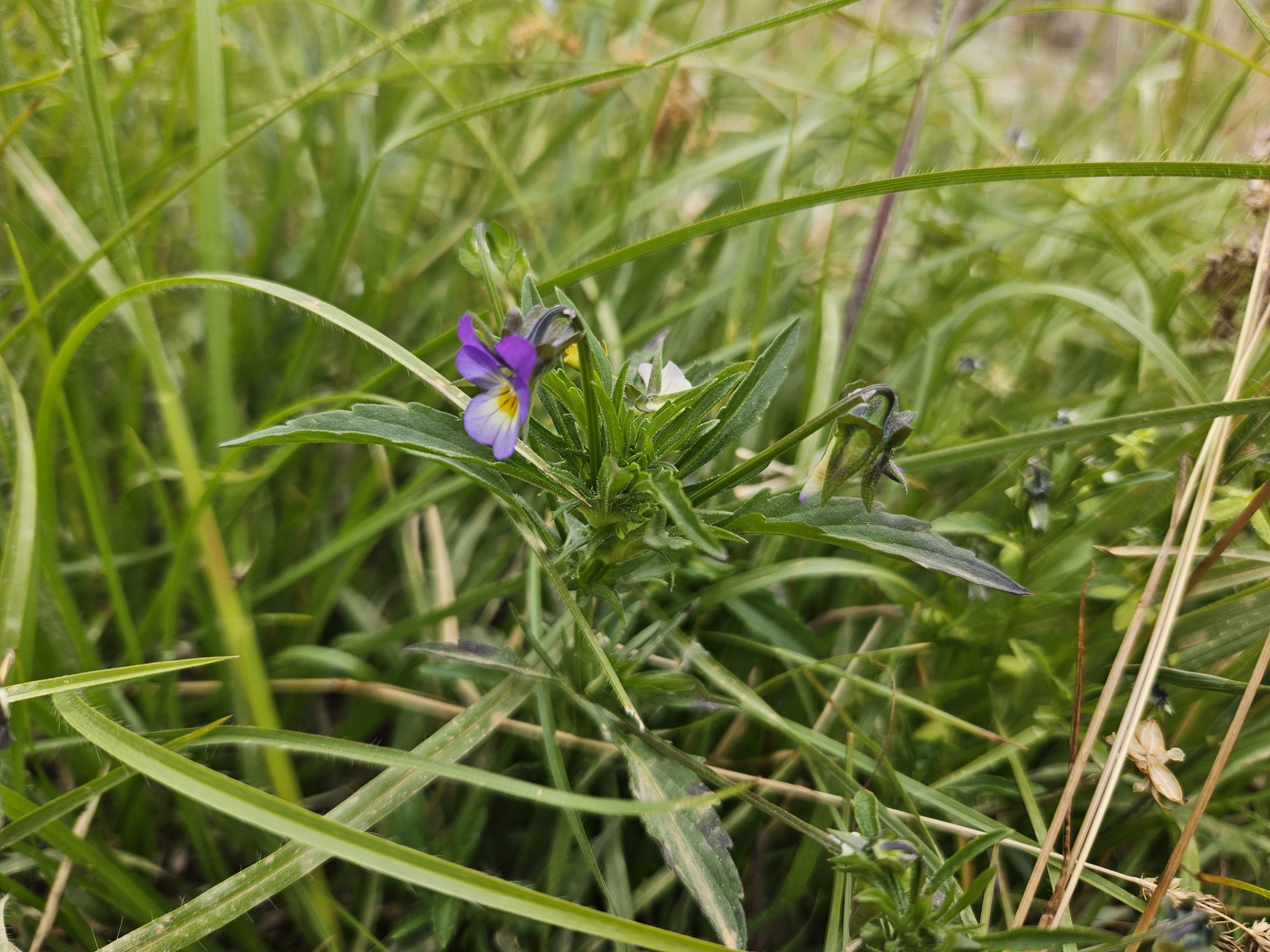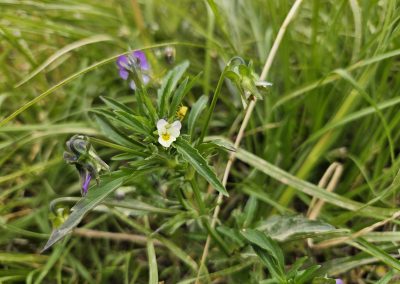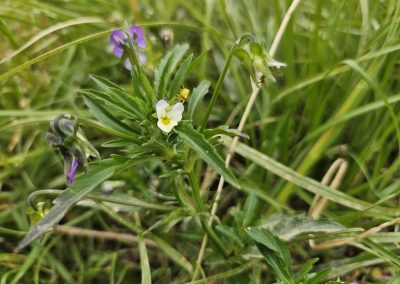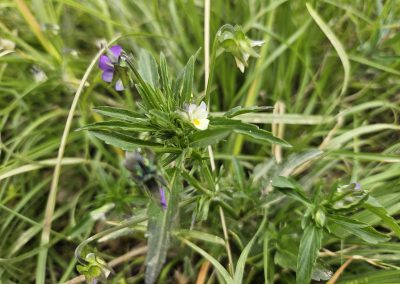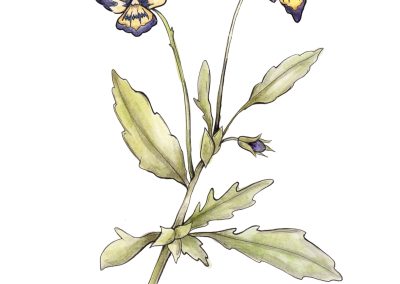Viola tricolor
Scientific description
Phylum: Angiospermatophyta (Magnoliophyta)
Class: Dicotyledonatae (Magnoliatae)
Subclass: Dileniidae
Order: Violales
Family: Violaceae
Common name: Three-spotted brothers
Origin: Native to Europe.
Description:
Annual herbaceous plant, up to 30 cm tall, with taproot bearing absorbent hairs. Stem green, short, covered with fine hairs. Leaves oval, elongated, rarely toothed, short petiole, with stipules. Flowers on long peduncle, with long sepals and five petals, 1.5 cm in diameter, hermaphrodite and fertile. Lower petal yellow, spurred; upper petals dark purple; lateral petals white or bluish-purple. Blooms April–September. Fruit: valvicidal oblong-ovate capsule. Each plant produces 40–100 seeds.
Propagation: Seeds as soon as fruits reach physiological maturity.
Ecology: Common in meadows, forest edges, and rocky areas from hills to alpine zones. Prefers sunny places, medium-textured, neutral to acidic soils; drought- and frost-resistant.
Uses: Pharmaceutical importance. Aerial parts contain saponosides, flavonoids, salicylic compounds, carotenoids, anthocyanins, tannins, volatile oils, vitamins. Used for dermatological and renal issues, rheumatism, cough, bronchitis, epilepsy, asthma. Teas diuretic; leaves for chemical indicators; flowers for natural dyes. Also ornamental, solitary or in groups.
Threats: Euroasiatic flora; medicinal plant; locally disappeared due to intensive harvesting.
Încrengătura: Angiospermatophyta (Magnoliophyta)
Clasa: Dicotyledonatae (Magnoliatae)
Subclasa: Dileniidae
Ordinul: Violales
Familia: Violaceae
Denumire populară: trei frați pătați, panseluță
Origine: specia este nativă în Europa.
Descriere:
Plantă anuală, ierbacee, până la 30 cm. Rădăcină pivotantă cu perișori absorbanți. Tulpina verde, scurtă, cu peri scurți. Frunze ovale, alungite, rar dințate, pețiol scurt, cu stipe. Florile au peduncul lung, sepale lunguiețe, cinci petale, diametru 1,5 cm, hermafrodite, fertile. Petala inferioară galbenă, pintenată; superioare violet închis; laterale alb/violet-albăstrui. Înflorește aprilie–septembrie. Fruct: capsulă valvicidă, alungit-ovată. Plantă produce 40–100 semințe.
Înmulțire: semințe la maturitatea fiziologică a fructelor.
Ecologie: comună, spontană; lunci, margini păduri, stâncării, zone de deal până la etaj alpin. Locuri însorite, sol mediu, neutru–acid, rezistentă la secetă și ger.
Utilizare: Plantă farmaceutică. Părțile aeriene conțin saponozide, flavonoide, compuși salicilici, carotenoide, antociani, tanin, ulei volatil, vitamine. Folosită pentru afecțiuni dermatologice, renale, reumatism, tuse, bronșite, epilepsie, astm. Ceaiuri diuretice, frunze pentru indicator chimic, flori pentru vopsele naturale. Plantă decorativă solitară sau în grup.
Pericol: Element floristic euroasiatic; recoltarea intensivă a dus la dispariția în anumite zone.
Φυλοταξία: Angiospermatophyta (Magnoliophyta)
Κλάση: Dicotyledonatae (Magnoliatae)
Υποκλάση: Dileniidae
Τάξη: Violales
Οικογένεια: Violaceae
Δημοφιλής ονομασία: βιόλα, πανσές
Προέλευση: Ευρωπαϊκή.
Περιγραφή:
Ετήσιο ποώδες φυτό, ύψος έως 30 εκ., με κατακόρυφη ρίζα και απορροφητικούς τριχίτες. Κορμός πράσινος, κοντός με κοντές τρίχες. Φύλλα ωοειδή, επιμήκη, σπανίως δονημένα, με σύντομο μίσχο. Άνθη με μακρύ ποδίσκο, επιμήκεις σέπαλες, πέντε πέταλα, διάμετρος 1,5 εκ., ερμαφρόδιτα και γόνιμα. Κάτω πέταλο κίτρινο με αγκάθι, ανώτερα σκοτεινό βιολετί, πλευρικά άσπρα ή μπλε-βιολετί. Ανθίζει Απρίλιο–Σεπτέμβριο. Καρπός: κάψα, παράγει 40–100 σπόρους.
Αναπαραγωγή: Μέσω σπόρων στη φυσιολογική ωριμότητα των καρπών.
Οικολογία: Κοινό φυτό, λιβάδια, παρυφές δασών, βραχώδεις πλαγιές, από περιοχή πεδιάδας έως αλπικό επίπεδο. Ηλιόλουστες περιοχές, μέση σύσταση εδάφους, ουδέτερο έως όξινο, ανθεκτικό σε ξηρασία και ψύχος.
Χρήση: Φαρμακευτική σημασία. Αεροφόρα μέρη με σαπωνίνες, φλαβονοειδή, σαλικυλικά, καροτενοειδή, ανθοκυανίνες, τανίνες, αιθέρια έλαια, βιταμίνες. Θεραπεία δερματολογικών/νεφρικών προβλημάτων, ρευματισμών, βήχα, βρογχίτιδας, επιληψίας, άσθματος. Αφεψήματα διουρητικά, φύλλα για δείκτες χημείας, άνθη για φυσικές βαφές. Διακοσμητικό φυτό, μεμονωμένο ή σε ομάδες.
Κίνδυνος: Φαρμακευτικό φυτό, λόγω εντατικής συλλογής έχει εξαφανιστεί σε ορισμένες περιοχές.
Taxon : Angiospermatophyta (Magnoliophyta)
Classe : Dicotyledonatae (Magnoliatae)
Sous-classe : Dileniidae
Ordre : Violales
Famille : Violaceae
Nom commun : Pensée sauvage
Origine : Europe.
Description :
Plante annuelle herbacée, jusqu’à 30 cm. Racine pivotante avec poils absorbants. Tige verte, courte, poils fins. Feuilles ovales, allongées, rarement dentées, court pétiole, stipules. Fleurs hermaphrodites sur long pédoncule, sépales longs, cinq pétales, diamètre 1,5 cm. Pétale inférieur jaune, éperonné ; supérieur violet foncé ; latéraux blanc ou bleu-violet. Floraison avril–septembre. Fruit : capsule oblongue-ovale, 40–100 graines par plante.
Multiplication : Graines à maturité physiologique.
Écologie : Espèce commune, prairies, lisières, rochers zones collinéennes jusqu’aux étages alpins. Préfère ensoleillé, sol moyen, neutre à acide, résistant sécheresse et gel.
Utilisation : Parties aériennes contiennent saponosides, flavonoïdes, composés salicyliques, caroténoïdes, anthocyanes, tannins, huiles essentielles, vitamines. Traitement dermatologique, rénal, rhumatismes, toux, bronchite, épilepsie, asthme. Tisanes diurétiques. Feuilles pour indicateurs chimiques, fleurs pour teintures naturelles. Ornementale seule ou en groupe.
Menaces : Plante médicinale, disparition locale par récolte intensive.
Creative writing inspired by Viola tricolor
Written by Carp Delia
Trei Frați Pătați: Legends and Medicinal Marvels
In the heart of ancient folklore, there existed three valiant princes—handsome, courageous, and bound by a shared destiny. Their father, an emperor, ruled over a kingdom where fear reigned. A fearsome dragon, its scales as dark as midnight, terrorized the land, devouring livestock and threatening the lives of innocent villagers.
The three brothers, fueled by a sense of duty and honor, embarked on a perilous quest to confront the dragon. Armed with swords forged by celestial blacksmiths, they ascended the treacherous slopes of the Himalayas, where the dragon’s lair lay hidden. Their journey was fraught with danger—icy winds, yawning chasms, and the haunting cries of unseen creatures.
Finally, they stood before the beast—a monstrous creature with eyes that glowed like embers. The battle raged, and the brothers fought with unwavering resolve. Their swords clashed against scales, and their hearts beat in unison. In a climactic moment, they pierced the dragon’s heart, ending its reign of terror.
But the dragon’s dying breath carried a curse. It prophesied that the brothers, victorious yet marked by fate, would transform into a flower—a symbol of their bravery and sacrifice. And so, they became Trei Frați Pătați, their petals adorned with vivid spots—a testament to their valor and the dragon’s curse.


